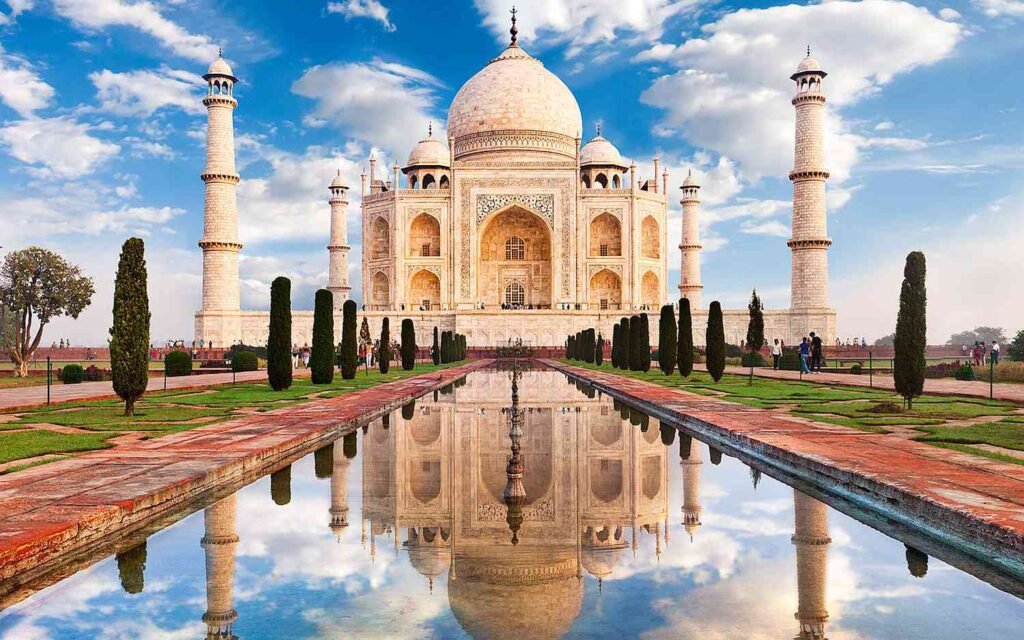
Nestled on the banks of the Yamuna River in the city of Agra, the Taj Mahal stands as a timeless tribute to love, beauty, and architectural brilliance. This majestic mausoleum, often hailed as the “Crown Jewel of India,” is a UNESCO World Heritage Site and one of the most iconic symbols of the country’s rich cultural heritage. Join us on a journey to explore the enchanting allure and historical significance of the Taj Mahal, a masterpiece that continues to captivate hearts and minds around the world.
A Monument to Eternal Love
Commissioned by the Mughal Emperor Shah Jahan in 1632 as a mausoleum for his beloved wife Mumtaz Mahal, the Taj Mahal is a testament to one of the greatest love stories in history. Legend has it that Shah Jahan was grief-stricken by Mumtaz Mahal’s death during childbirth and vowed to create a monument that would immortalize their love for eternity.
Architectural Splendor
1. Design and Layout
Designed by the renowned architect Ustad Ahmad Lahauri, the Taj Mahal is a masterpiece of Mughal architecture, blending elements of Persian, Islamic, and Indian styles. The mausoleum is built entirely of white marble, which shimmers in the sunlight and changes color throughout the day, creating a mesmerizing effect. The complex is laid out in perfect symmetry, with a central dome flanked by four minarets and surrounded by lush gardens, reflecting pools, and ornamental fountains.
2. Intricate Detailing
One of the most striking features of the Taj Mahal is its intricate inlay work and decorative motifs, which adorn every surface of the structure. Delicate carvings, intricate arabesques, and precious gemstones such as jasper and jade embellish the marble façade, creating a symphony of light and shadow that dazzles the eye.
3. Symbolism and Symbolic Meaning
Every aspect of the Taj Mahal is imbued with symbolic meaning, reflecting the spiritual and philosophical beliefs of the Mughal dynasty. The four minarets represent the four corners of the world, while the central dome symbolizes the heavenly realm. Inscriptions from the Quran adorn the walls, celebrating the virtues of love, devotion, and eternal life.
Exploring the Taj Mahal
1. Main Mausoleum
Step through the imposing gateway of the Taj Mahal and enter a world of serene beauty and tranquility. The main mausoleum houses the cenotaphs of Shah Jahan and Mumtaz Mahal, surrounded by delicate marble screens and ornamental niches. Visitors can pay their respects to the couple and marvel at the exquisite craftsmanship of the interior decorations.
2. Gardens and Reflecting Pools
Stroll through the meticulously manicured gardens surrounding the Taj Mahal, which are laid out in the traditional Persian charbagh style. Symmetrical pathways, lush greenery, and fragrant flowers create a peaceful oasis amidst the bustling city. Be sure to pause at the reflecting pools, which offer stunning views of the mausoleum mirrored in the water.
3. Sunrise and Sunset Views
For a truly unforgettable experience, visit the Taj Mahal at sunrise or sunset, when the marble façade is bathed in soft golden light. Watch as the colors of the sky shift and change, casting a warm glow over the monument and transforming it into a vision of ethereal beauty.
Cultural Significance
Beyond its architectural magnificence, the Taj Mahal holds immense cultural and symbolic significance for the people of India and the world. It serves as a symbol of enduring love, devotion, and the power of human creativity to transcend time and space. Its timeless beauty has inspired poets, artists, and writers for centuries, cementing its status as one of the most cherished and beloved landmarks on the planet.
Visitor Information
Opening Hours
The Taj Mahal is open to visitors every day except Fridays, from sunrise to sunset. It’s advisable to arrive early to avoid crowds and take advantage of the best lighting for photography.
Getting There
Agra is well-connected by road, rail, and air, making it easily accessible from major cities such as Delhi, Jaipur, and Mumbai. Visitors can also opt for guided tours or hire private transportation to the Taj Mahal from Agra.
Tips for Visitors
- Dress modestly and respectfully, covering shoulders and knees out of respect for the cultural significance of the site.
- Wear comfortable shoes, as you’ll be doing a lot of walking on marble surfaces.
- Bring plenty of water, sunscreen, and a hat to protect yourself from the sun, especially during the hot summer months.
Conclusion
The Taj Mahal stands as a timeless testament to the power of love, beauty, and human creativity, transcending centuries to inspire awe and admiration in all who behold it. Whether you’re marveling at its exquisite architecture, wandering through its serene gardens, or simply contemplating its profound symbolism, the Taj Mahal is sure to leave a lasting impression on your heart and soul. As you stand before this magnificent monument, surrounded by the echoes of history and the whispers of eternity, you can’t help but feel a sense of wonder and gratitude for the opportunity to witness such unparalleled beauty and grandeur.
